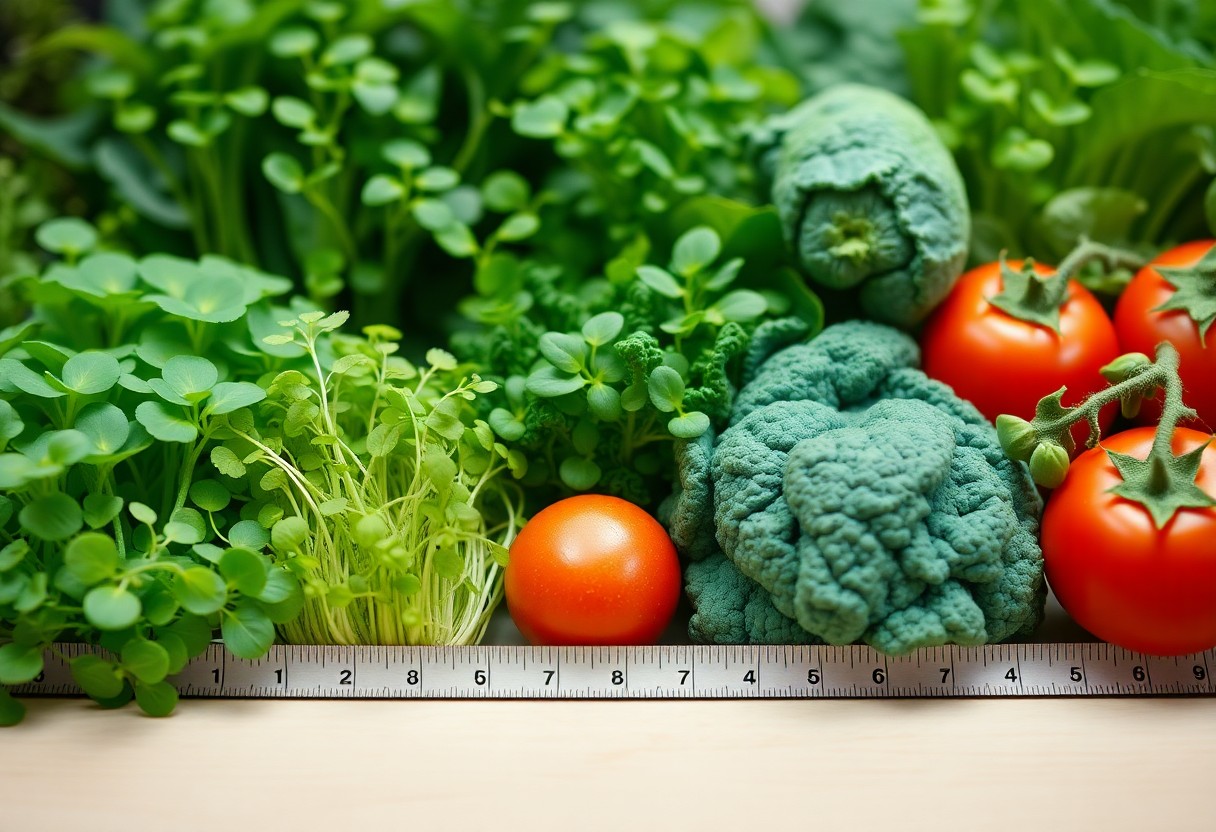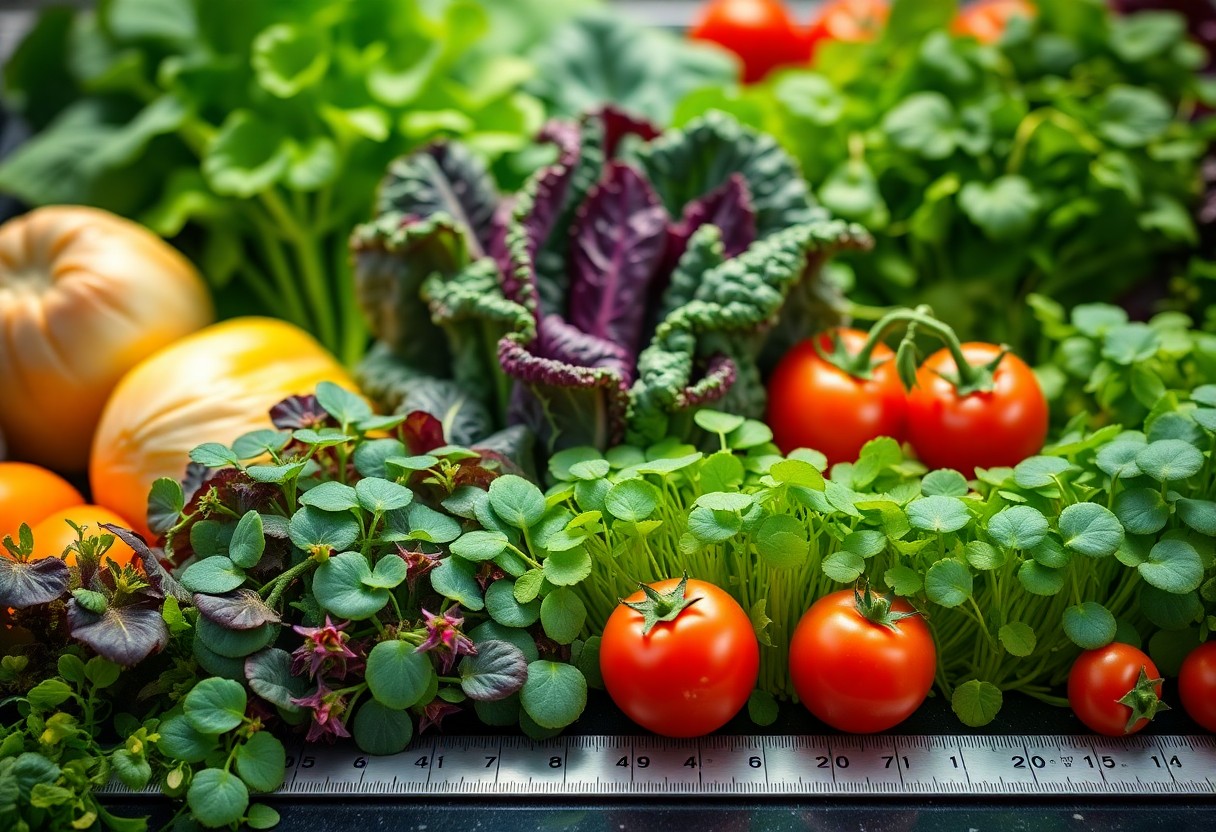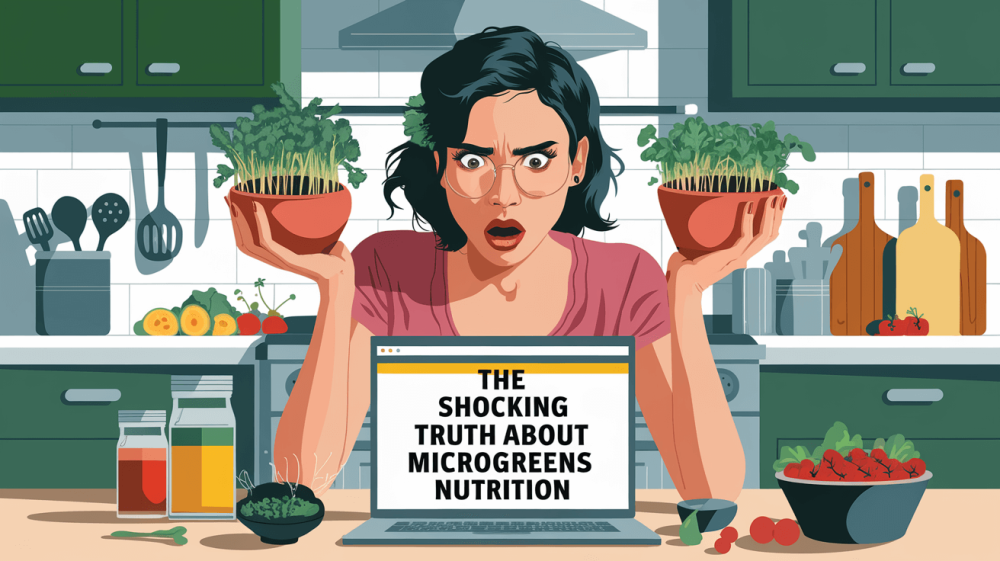Have you noticed those tiny, vibrant greens garnishing your restaurant plate? Those aren’t just for decoration – they’re microgreens, and they might be nutritional powerhouses hiding in plain sight.
But are these miniature plants actually healthier than the full-grown vegetables in your crisper drawer?
The short answer: Yes, microgreens can contain up to 40 times more nutrients than their mature counterparts. But there’s much more to this story that health-conscious eaters should know.
In this comprehensive guide, we’ll explore the surprising nutritional benefits of microgreens, compare them to mature vegetables with scientific evidence, and show you exactly how to incorporate these nutrient-dense foods into your daily diet.
Let’s dive in!

What Are Microgreens? Understanding the Basics
Microgreens are young vegetable greens harvested just 7-14 days after germination, when they’ve developed their first true leaves. They sit at the perfect middle ground between sprouts and baby greens in the plant growth cycle.
Unlike sprouts (germinated seeds eaten whole, including the roots) or mature vegetables (fully developed plants), microgreens represent a unique growth stage with distinct nutritional properties.
Common varieties include:
- Broccoli microgreens
- Radish microgreens
- Sunflower microgreens
- Pea shoots
- Red cabbage microgreens
- Cilantro microgreens
- Amaranth microgreens
The Nutritional Science: Microgreens vs. Mature Vegetables
Research from the USDA and the University of Maryland has confirmed what many nutrition experts suspected: microgreens pack a significantly higher concentration of nutrients compared to their fully-grown counterparts.
Key Nutritional Advantages of Microgreens
| Microgreen Variety | Nutrient | Comparison to Mature Vegetable |
|---|---|---|
| Red Cabbage | Vitamin C | 6x higher |
| Red Cabbage | Vitamin E | 40x higher |
| Cilantro | Beta-carotene | 3x higher |
| Radish | Vitamin C | 6x higher |
| Amaranth | Vitamin K | 4x higher |
| Broccoli | Sulforaphane | 10-100x higher |
Why Are Microgreens More Nutritious?
This exceptional nutrient density isn’t just a coincidence. Several factors contribute to the nutritional superiority of microgreens:
Seed Energy Utilization: Microgreens efficiently convert seed energy into vital nutrients during their rapid growth phase.
Growth Stage Concentration: Young plants produce higher concentrations of vitamins and protective compounds during early development.
Bioactive Compounds: Microgreens contain elevated levels of antioxidants and phytochemicals that plants produce to protect themselves during vulnerable growth stages.
Nutrient Efficiency: Young plants haven’t developed the fibrous cell walls of mature vegetables, making their nutrients more bioavailable to our bodies.

Health Benefits of Microgreens: Beyond Basic Nutrition
The concentrated nutrients in microgreens translate to significant health benefits:
Immune System Support
The high vitamin C content in many microgreens varieties (particularly broccoli, radish, and red cabbage) provides powerful immune system support. Just one ounce of sunflower microgreens contains nearly 100% of your daily vitamin C requirement.
Antioxidant Protection
Microgreens are rich in antioxidants like polyphenols, which help neutralize harmful free radicals in the body. Red cabbage and amaranth microgreens rank particularly high in antioxidant content.
Heart Health Benefits
The potassium, fiber, and polyphenols found in microgreens support cardiovascular health by helping regulate blood pressure and reduce inflammation.
Digestive Health
The tender nature of microgreens makes them easier to digest than mature vegetables, while still providing beneficial fiber for gut health.
Comparing Microgreens to Mature Vegetables
If someone is wondering whether to add microgreens to their diet, they’ll be amazed to learn that these tiny powerhouses pack quite a punch. Like I said before studies show that microgreens can contain up to 40 times more nutrients than their mature counterparts.
Microgreens vs. Mature Vegetables
| Microgreens | Mature Vegetables |
|---|---|
| Higher nutrient concentration | Lower nutrient density |
| More intense flavors | Milder taste |
| Quick harvest (7-14 days) | Longer growing period |
Nutrient Density Differences
On average, microgreens showcase remarkable nutritional superiority. Red cabbage microgreens, for instance, contain 40 times more vitamin E than mature cabbage. They’re like nature’s multivitamin, packed into tiny, delicious sprouts that anyone can grow on their windowsill.
Bioavailability of Nutrients
An interesting aspect of microgreens is their enhanced nutrient absorption rate. Their tender structure makes it easier for the body to break down and absorb imperative vitamins and minerals compared to mature vegetables with tougher cell walls.
Consequently, this improved bioavailability means that even smaller portions of microgreens can deliver significant nutritional benefits.
The body can extract nutrients more efficiently, making them an excellent choice for those who struggle with nutrient absorption or want to maximize their nutritional intake without eating large volumes of food. It’s like getting the benefits of a whole garden in just a handful of tiny greens!
Health Benefits
Despite their tiny size, microgreens pack a powerful nutritional punch. Studies show these young seedlings contain up to 40 times more nutrients than their fully-grown counterparts.
They’re bursting with vitamins C, E, and K, along with imperative minerals like iron and zinc. While a mature broccoli might take months to reach your plate, these mini-versions deliver similar benefits in just a couple of weeks.
Immune System Support
Along with their impressive nutrient density, microgreens offer a natural boost to the immune system. They’re loaded with antioxidants that fight harmful free radicals in the body. Red cabbage microgreens, for instance, contain up to 6 times more vitamin C than their mature version – that’s like having six oranges in one tiny handful!
Disease Prevention Potential
Support for overall health comes naturally with these mighty sprouts. Research indicates that microgreens may help reduce the risk of various diseases, including certain types of cancer and heart disease. Their high levels of polyphenols and other bioactive compounds make them particularly effective at combating inflammation.
This disease-fighting potential stems from the unique growth stage at which microgreens are harvested. During their early development, these plants produce higher concentrations of protective compounds to defend against environmental threats.
For humans, these same compounds translate into powerful health benefits. Studies have shown that regular consumption of microgreens may help lower blood pressure and reduce the risk of chronic diseases.
The 5 Most Nutritious Microgreens You Should Try
While all microgreens offer impressive nutrition, these five varieties consistently rank highest in nutrient density:
- Red Cabbage Microgreens: Exceptional source of vitamins C, E, and K, with 40 times more vitamin E than mature cabbage.
- Broccoli Microgreens: Contains sulforaphane, a powerful cancer-fighting compound, at concentrations 10-100 times higher than mature broccoli.
- Sunflower Microgreens: Rich in protein, vitamin E, and zinc – perfect for vegetarians and vegans seeking plant-based nutrition.
- Pea Shoots: Excellent source of vitamins A and C, folate, and protein, with a sweet flavor that even children enjoy.
- Radish Microgreens: Contains 6 times more vitamin C than mature radishes, with a spicy kick that adds flavor to any dish.
Growing and Storing for Maximum Nutrition
Not all microgreens are created equal when it comes to nutrient content. The growing conditions, harvesting timing, and storage methods can make a significant difference in nutritional value. Studies show that microgreens grown under optimal conditions can contain up to 40 times more nutrients than their mature counterparts.
Best Growing Practices
Growing microgreens requires attention to detail and the right environment. Proper lighting, clean water, and quality soil form the foundation for nutrient-rich shoots. Maintaining temperatures between 65-75°F helps maximize vitamin content.
Here’s what growers need:
- Full spectrum LED lights for indoor growing
- Organic potting mix rich in nutrients
- Good air circulation to prevent mold
- Clean water for daily misting
Knowing these basics will help produce the most nutritious harvest.
Storage Tips to Preserve Nutrients
Besides proper harvesting, storage plays a vital role in maintaining nutritional value. Fresh microgreens should be kept between 35-40°F in airtight containers lined with paper towels. Here’s what to consider:
- Avoid washing until ready to use
- Store in glass containers rather than plastic
- Check daily for moisture buildup
- Use within 7-10 days of harvest
Knowing proper storage techniques can extend shelf life by up to two weeks.
Preserve nutrients by handling microgreens with care. Temperature fluctuations can cause rapid nutrient loss, while exposure to direct sunlight can degrade vitamins.
Studies indicate that microgreens stored at optimal conditions retain up to 85% of their nutritional value for the first week. A simple trick is using a vacuum-sealed container to minimize oxidation. Knowing these advanced storage methods helps maintain maximum nutritional benefits throughout the shelf life.
How to Incorporate Microgreens Into Your Diet
Adding microgreens to your meals is surprisingly easy:
Everyday Uses for Microgreens
- Breakfast Boost: Top avocado toast or scrambled eggs with a handful of microgreens
- Sandwich Upgrade: Replace lettuce with microgreens for added nutrition and flavor
- Salad Enhancement: Mix microgreens with regular salad greens for nutritional variety
- Smoothie Addition: Blend mild varieties like pea shoots into fruit smoothies
- Soup Garnish: Add microgreens just before serving soups for a nutrient and flavor boost
- Pizza Topper: Sprinkle microgreens on pizza after baking for a fresh, nutritious finish
Simple Microgreens Recipe: Nutrient-Packed Microgreen Pesto
Ingredients:
- 2 cups microgreens (sunflower, basil, or a mix)
- 1/3 cup pine nuts or walnuts
- 2 garlic cloves
- 1/2 cup olive oil
- 1/4 cup grated Parmesan cheese
- Salt and pepper to taste
Instructions:
Use as a spread, pasta sauce, or dip
Pulse nuts and garlic in a food processor until coarsely chopped
Add microgreens and pulse until combined
Slowly add oil while processing
Stir in cheese and season with salt and pepper
Daily Recommended Intake
Between one and two cups of microgreens daily can provide significant nutritional benefits. These nutrient-dense plants contain high levels of vitamins C, E, and K. While they shouldn’t replace regular vegetables entirely, they make an excellent supplement to a balanced diet.
Another factor to consider is that different microgreen varieties offer varying nutritional profiles. Red cabbage microgreens contain 40 times more vitamin E than mature cabbage, while radish microgreens are packed with vitamin C. However, it’s best to consult with a healthcare provider before making any major dietary changes, especially for those on blood-thinning medications due to high vitamin K content.
The Bottom Line: Are Microgreens Really Healthier?
The scientific evidence is clear: microgreens do contain significantly higher concentrations of many essential nutrients compared to their mature counterparts. Their exceptional vitamin, mineral, and antioxidant content makes them a valuable addition to any diet.
However, the healthiest approach isn’t to choose between microgreens and mature vegetables, but to incorporate both into your meals. Microgreens provide concentrated nutrition and intense flavors, while mature vegetables offer different beneficial compounds and dietary fiber.
By adding a variety of microgreens to your regular vegetable intake, you can significantly boost your overall nutrient consumption without major dietary changes – a simple, delicious way to enhance your health one bite at a time.
Ready to try microgreens? Start with a small container on your windowsill or look for fresh microgreens at your local farmers’ market or grocery store. Your body will thank you for the nutritional upgrade!
FAQ
Q: What exactly are microgreens, and how do they differ from sprouts?
A: Microgreens are baby vegetables harvested just after their first true leaves appear, typically 7-14 days after germination. Think of them as teenage plants – not quite grown up, but past their sprout phase. Unlike sprouts (which are eaten whole, root and all), microgreens are cut above the soil line and only the stem and leaves are consumed. They’re like the “mini-me” version of their full-grown counterparts!
Q: How much more nutritious are microgreens compared to mature vegetables?
A: Hold onto your gardening hats! Research shows microgreens pack a serious nutritional punch – containing up to 40 times more nutrients than their mature counterparts. For example, red cabbage microgreens have 40 times more vitamin E and 6 times more vitamin C than mature cabbage. It’s like getting a whole salad’s worth of nutrients in just a handful of these tiny powerhouses.
Q: Which microgreens offer the biggest nutritional bang for your buck?
A: Red cabbage, cilantro, and radish microgreens top the charts. These little champions are bursting with vitamins C, E, and K, plus antioxidants. Amaranth and sunflower microgreens are also superstars, loaded with protein and imperative minerals. They’re like nature’s multivitamins, but tastier!
Q: Do microgreens lose their nutritional value quickly after harvesting?
A: Yes, these delicate greens are best eaten fresh. Their nutrient content starts declining within hours of harvest. Think of them as tiny time bombs of nutrition – you’ll want to use them within 4-7 days of purchase, even when refrigerated. Pro tip: keep them in a container with slightly damp paper towels to maintain freshness.
Q: Can microgreens replace regular vegetables in my diet?
A: While microgreens are nutritional powerhouses, they shouldn’t completely replace mature vegetables. Think of them as your diet’s supporting actor – amazing in their role but not the whole show. Mature vegetables offer different benefits, including fiber and certain compounds that develop during full growth. The best approach? Use both!
Q: Are homegrown microgreens as nutritious as store-bought ones?
A: Absolutely! In fact, homegrown microgreens might even be more nutritious since you can eat them minutes after harvesting. Plus, you control the growing conditions and avoid any commercial packaging deterioration. It’s like having a tiny vitamin factory right on your windowsill – and it’s easier than trying to teach a cat to fetch!
Q: How can I get the most nutritional value from my microgreens?
A: Eat them raw when possible – cooking can decrease their nutritional content. Add them to sandwiches, salads, smoothies, or as garnishes. Store them properly (don’t wash until ready to use), and eat them within a week of purchase or harvest. They’re like little nutrition ninjas – they work best when they’re fresh and ready for action!





